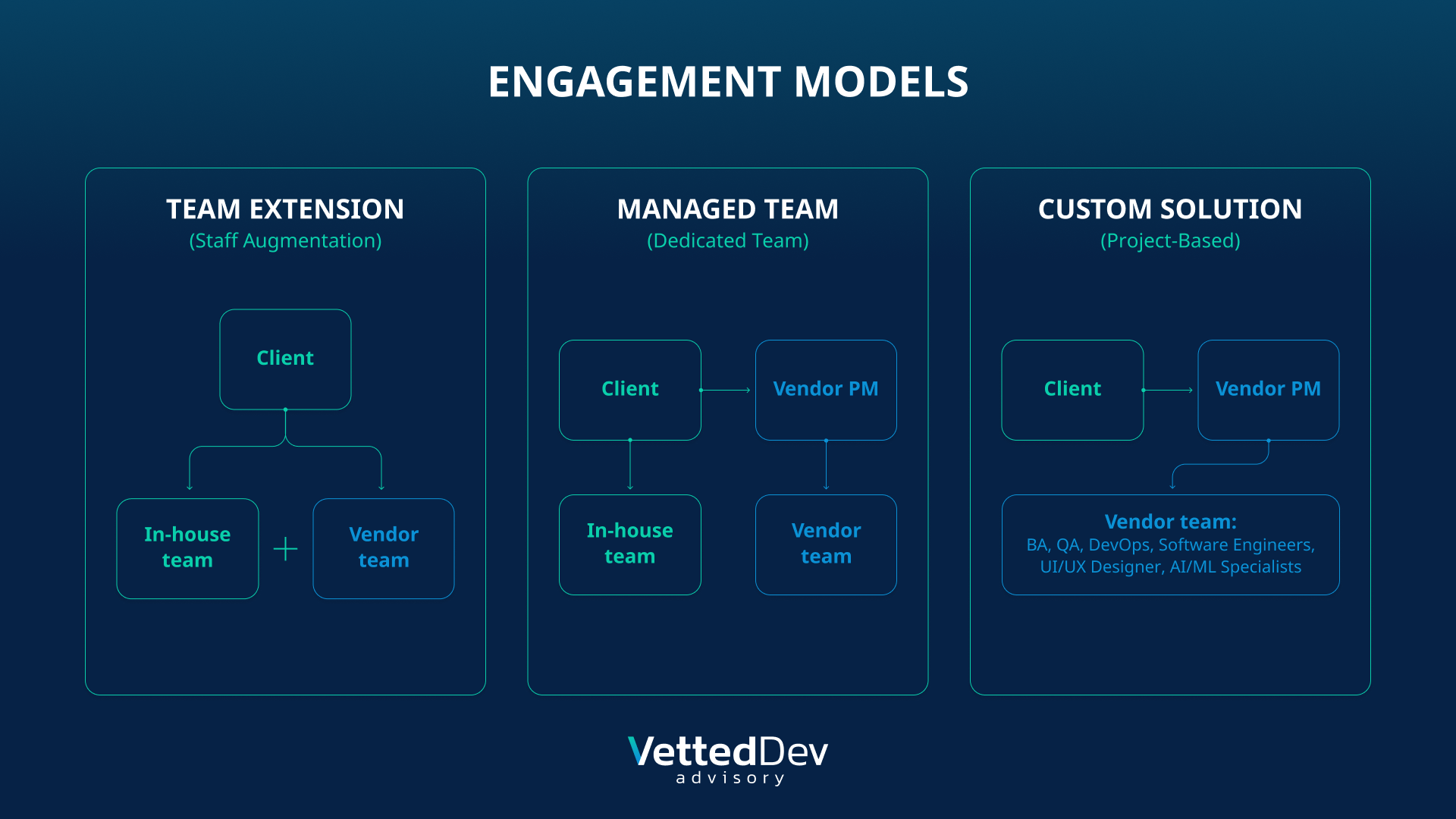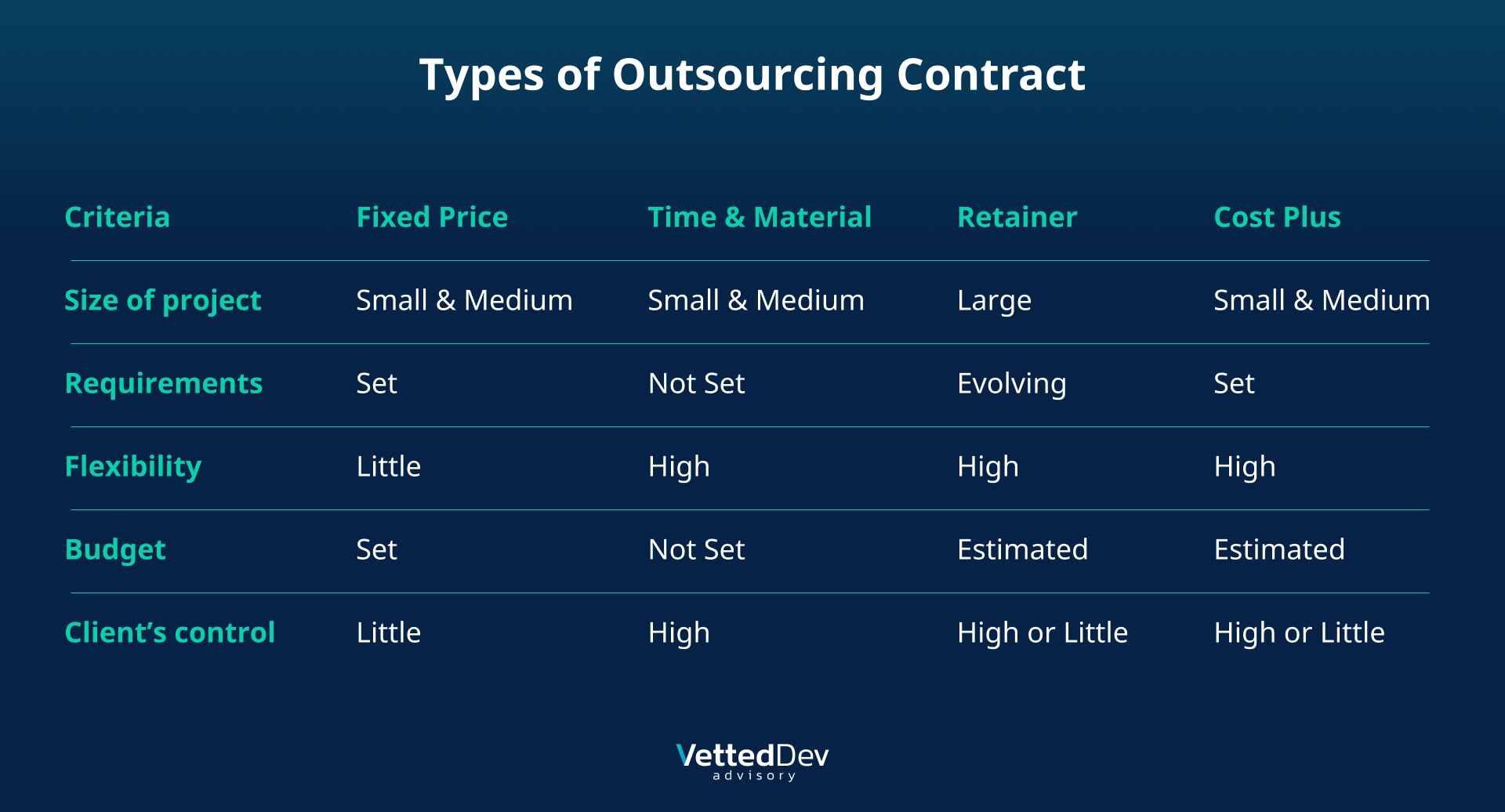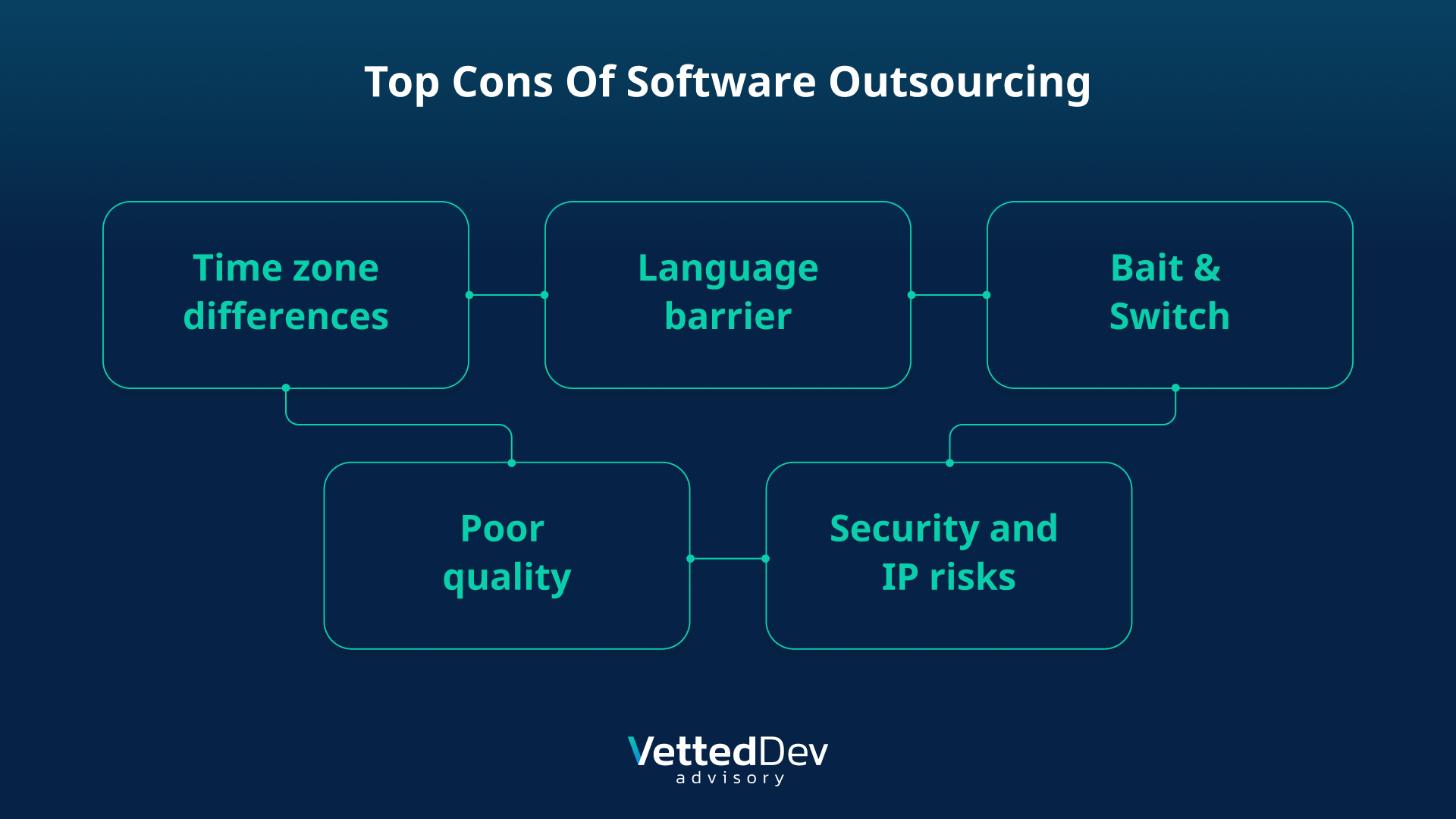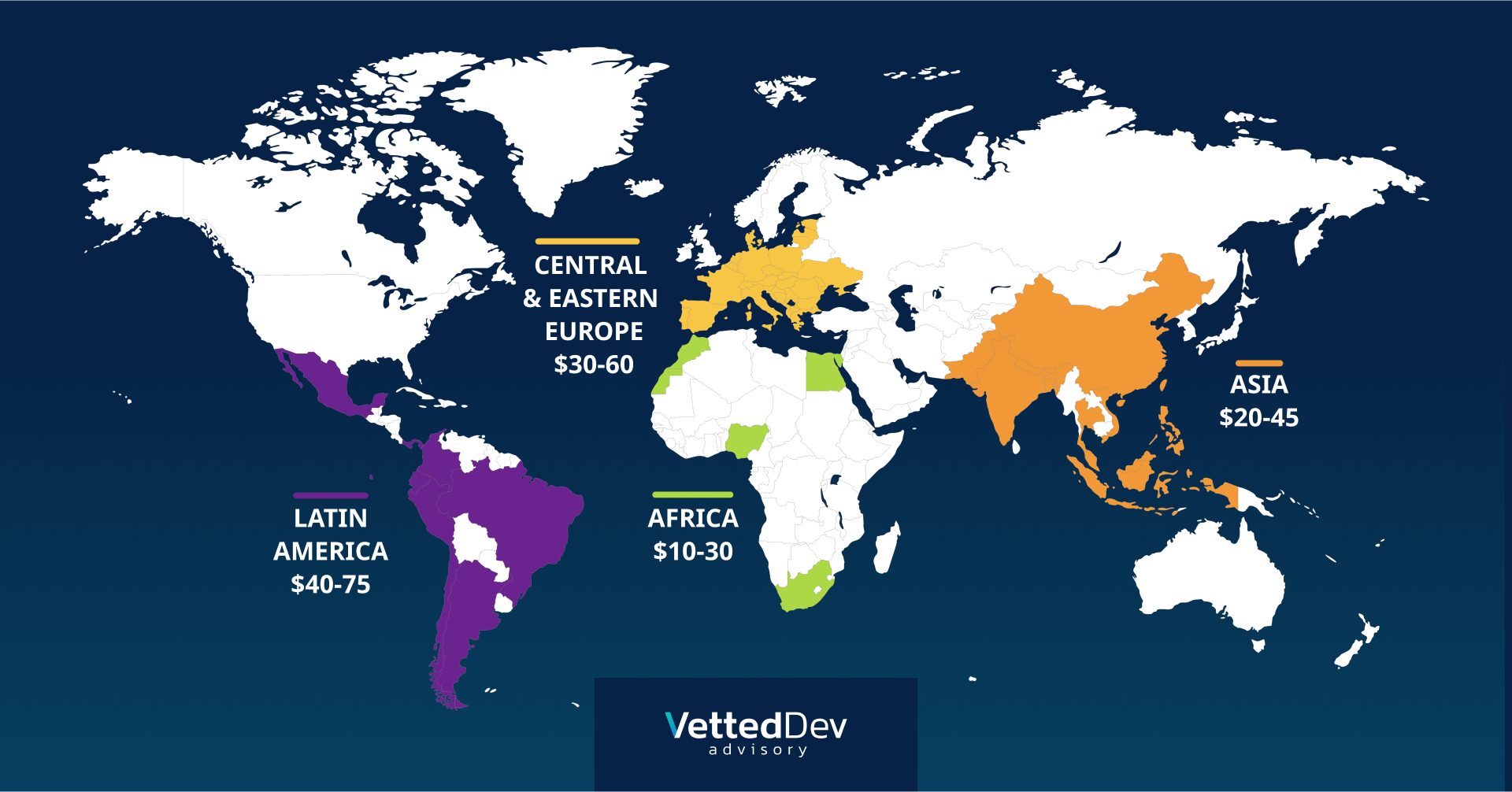Guide To Software Outsoursing
By VettedDev.net
Introduction
Outsourcing software development isn’t just about cutting costs anymore. It’s become a powerful tool for businesses that want to accelerate growth, access top-tier global talent, and stay competitive in a fast-moving digital world. But here’s the challenge: with so many outsourcing models, destinations, and vendors out there, how do you choose the right partner—and make sure you’re getting real, long-term value?
At Vetted Dev, we’ve worked with businesses of all sizes to navigate the outsourcing landscape. This guide distills those insights into actionable strategies. We’ll break down the pros and cons of outsourcing software development and share what actually works—based on real-world experience and proven industry practices.
Whether you’re considering outsourcing for the first time or looking to fine-tune an existing partnership, this guide will help you make informed decisions that move your business forward.
Let’s get started.
What Is It?
At its core, software product development outsourcing means bringing in an external vendor to design, build, and often maintain your software solutions. Instead of hiring and managing an in-house team, you tap into a highly skilled talent pool that’s already equipped with the expertise you need.
Outsourcing gives businesses the flexibility to move faster, reduce overhead, and deliver high-quality software without getting bogged down in day-to-day technical management. It’s a smart way to stay focused on your core strategy while a trusted development partner takes care of writing the code.
Common, Real Business Challenges Solved by Outsourcing Software Development
1. Bridging Talent Gaps in High-Demand Skill Areas
Businesses often struggle to find and retain specialized talent (AI/ML, cloud engineering, cybersecurity, etc.). Outsourcing gives you fast access to vetted experts without the hassle of hiring full-time staff.
2. Speeding Up Time to Market
Competitive industries require fast product rollouts. Outsourcing provides additional resources and expertise, helping teams hit tight deadlines and launch products faster.
3. Optimizing Development Costs Without Sacrificing Quality
Scaling software teams in-house can be expensive. Outsourcing can reduce costs by tapping into global talent markets while maintaining quality through experienced vendors.
4. Scaling Teams and Projects on Demand
As projects grow, internal teams may hit capacity. Outsourcing allows companies to quickly scale up or down, bringing in extra developers or entire teams as needed.
5. Modernizing Legacy Systems to Stay Competitive
Legacy tech can slow businesses down. Outsourced teams often specialize in modernizing outdated systems, migrating to the cloud, or rearchitecting platforms for better performance and scalability.
6. Focusing Internal Teams on Core Business Goals
Outsourcing non-core development tasks lets internal teams focus on strategic priorities, like business growth or product innovation.
7. Reducing Risk with Shared Responsibility
Outsourcing vendors often have structured processes, security compliance, and risk mitigation frameworks, helping reduce project risks and ensuring smoother delivery.
8. Accessing Domain Knowledge in Specific Industries
Vendors often bring cross-industry experience that can inject new perspectives and best practices into software projects (e.g., fintech, healthcare, logistics).

Engagement models or how to do it right
When partnering with an outsourcing company, choosing the right cooperation model is critical. It defines how responsibilities are shared, how teams are managed, and the role your outsourcing partner will play in your software development lifecycle.
At Vetted Dev, we offer three core engagement models tailored to meet different business needs: Team Extension, Managed Team, and Custom Product Development. Here’s a breakdown of each model, their key advantages, and when they make the most sense.
1. Team Extension (Staff Augmentation)
Best for scaling your existing team quickly and filling skill gaps.
Team Extension (often referred to as staff augmentation) is the most flexible outsourcing model. It allows you to seamlessly extend your in-house engineering team with skilled external developers. These professionals work under your direct supervision, follow your processes, and integrate with your internal workflows.
Key Features:
- You remain in charge of team management, task allocation, and day-to-day communication.
- You control the hiring process, interviewing and selecting each team member.
- Scalability is a major advantage—you can add or reduce capacity based on your project’s needs.
Ideal for:
- Companies looking to quickly scale their teams without long-term hiring commitments.
- Businesses that need access to niche technical expertise to fill skill gaps.
- Projects where full control over the development process is important.
Things to Consider:
- You need to invest time in managing and onboarding external team members.
- Knowledge sharing and retention require deliberate effort to avoid dependencies.
2. Managed Team (Dedicated Team)
Best for outsourcing a specific project or component with minimal management overhead.
With the Managed Team model, you get a fully functional, autonomous development unit that works alongside your internal teams or independently. The outsourcing provider handles team setup, recruitment, and day-to-day management. A dedicated project manager ensures alignment with your goals and provides regular progress updates.
Key Features:
- The team is tailored to your project’s technical requirements and objectives.
- A dedicated project manager oversees delivery and reports directly to your stakeholders.
- Faster setup compared to Team Extension, as the outsourcing provider streamlines recruitment and onboarding.
Ideal for:
- Companies that want to delegate the delivery of specific product features or technical components.
- Projects that require specialized expertise and reliable delivery with minimal internal supervision.
- Businesses looking for predictable outcomes with clearly defined scopes and roadmaps.
Things to Consider:
- While the outsourcing partner manages the team, regular communication is essential to maintain alignment.
- A Managed Team operates as an external unit, so integration with internal processes should be planned.
3. Custom Product Development (End-to-End Solution Delivery)
Best for businesses looking to build complex products or undergo digital transformation.
Custom Product Development is a comprehensive outsourcing approach where the provider takes full responsibility for delivering an end-to-end software solution. From product discovery and business analysis to design, development, and long-term support—this model covers the entire product lifecycle.
Key Features:
- In-depth product discovery and validation are conducted before development begins.
- The outsourcing partner builds a dedicated team to handle all aspects of development, QA, DevOps, and support.
- Ongoing collaboration often evolves into a long-term strategic partnership, with the external team acting as an R&D hub.
Ideal for:
- Enterprises undergoing digital transformation or launching new business ventures.
- Complex projects that require strategy, technical leadership, and continuous innovation.
- Businesses looking for a long-term technology partner to handle product evolution and maintenance.
Things to Consider:
- Custom Product Development requires significant involvement during the discovery and strategy phases.
- It’s a long-term commitment, so choosing the right partner with proven expertise is critical.
Which Model Is Right for You?
- Choose Team Extension if you need to scale your team fast and want full control over development.
- Choose a Managed Team if you’re outsourcing a specific project and prefer a self-managed, autonomous team.
- Choose Custom Product Development if you need a partner to deliver a complex product or solution end-to-end.
Each model offers different levels of involvement, flexibility, and control. The right choice depends on your goals, internal resources, and the complexity of the product you’re building.

Contract Types
When outsourcing software development, selecting the right contract model is critical to ensuring alignment with business needs, budget constraints, and project complexity. Each model varies in terms of control, flexibility, scalability, and cost structure. Here are the primary software development outsourcing models to consider:
1. Fixed Price Model
The Fixed Price model is ideal for projects with a well-defined scope and set deadlines. Clients pay a predetermined amount for the entire project, ensuring cost predictability regardless of the actual time or resources used. This model minimizes budget risks but offers limited flexibility, making it best suited for projects with a stable scope of work (SOW). Any changes to the scope may require renegotiation, leading to additional costs or delays.
2. Time & Material (T&M) Model
The Time & Material model is the most flexible option, designed for projects with evolving requirements or unclear scopes. Clients pay based on the actual time and resources used, allowing for ongoing adjustments throughout the project. This model provides greater control but requires active oversight to prevent scope creep and manage costs effectively.
3. Retainer Model
The Retainer model involves clients paying a recurring fee (monthly, quarterly, or annually) for continued development services. This model is suitable for long-term partnerships where ongoing maintenance, support, or iterative improvements are needed. It ensures dedicated availability from the development team while providing predictable costs for the client. Clear expectations on deliverables and scope must be set to avoid misunderstandings.
4. Cost Plus Model
The Cost Plus model charges clients for the actual costs incurred in development—such as labor, infrastructure, and tools—plus a predetermined markup for profit. This model provides transparency and ensures all expenses are covered while maintaining profitability for the provider. It is particularly useful for projects where costs fluctuate or are difficult to estimate upfront. However, since the provider is reimbursed for all expenses, there is less incentive to minimize costs efficiently.
Each contract type has its advantages and challenges. Businesses should choose the most suitable model based on project complexity, budget flexibility, and required level of control.

What Are the Real Benefits of Outsourcing Software Development?
Outsourcing software development isn’t just about cutting costs. It’s a strategic move that helps businesses solve complex challenges, stay agile, and accelerate growth. Whether you’re scaling up, modernizing legacy systems, or bringing a product to market faster, the right outsourcing company can deliver measurable results.
Here’s a breakdown of the key benefits of outsourcing software development.
1. Access to Specialized Talent Without Hiring Delays
Finding and hiring specialized tech talent locally can be slow and expensive. Outsourcing allows businesses to quickly tap into a global talent pool and bring in developers with niche expertise whether in AI, cloud engineering, cybersecurity, or other advanced technologies. This removes geographical limitations and accelerates access to the right skills for complex projects.
2. Flexible Team Scaling Based on Project Needs
Business priorities shift, and workloads often fluctuate. Outsourcing gives you the flexibility to scale development teams up or down based on current demand without long-term commitments or increasing your permanent headcount. This is especially valuable for growing companies that need to stay lean while delivering on multiple initiatives.
3. Accelerated Time to Market
Speed is critical in competitive markets. Outsourced teams bring established workflows and experience, enabling faster ramp-up and shorter development cycles. By adding external capacity and expertise, businesses can reduce time to market for new products and features, gaining a competitive edge.
4. Established Processes and Development Best Practices
Trusted outsourcing vendors come with proven processes, structured project management, and quality assurance frameworks. This minimizes common project risks, ensures better communication, and leads to smoother execution—from initial planning to product delivery.
5. Reduced Operational Risks and Increased Business Continuity
Outsourcing helps mitigate the risks of resource shortages, team turnover, and fluctuating workloads. By distributing responsibilities across both internal and external teams, businesses can ensure greater stability and continuity in software delivery, even during periods of change or uncertainty.
6. Internal Teams Stay Focused on Strategic Priorities
By outsourcing software development tasks, internal teams can focus on high-impact areas such as innovation, customer experience, and long-term business strategy. External teams handle day-to-day development and support, freeing up internal resources to work on initiatives that drive growth.
7. Cost Efficiency with Greater Flexibility
Outsourcing reduces the overhead associated with recruiting, onboarding, training, and retaining in-house developers. Additionally, businesses avoid investing in infrastructure, tools, and office space. With outsourcing, you pay for what you need, when you need it and allow for more efficient budget allocation and financial flexibility.
8. Faster Adoption of Emerging Technologies
Adopting new technologies in-house often requires significant time and investment. Outsourcing providers typically have teams experienced in the latest frameworks, platforms, and methodologies, helping businesses integrate advanced solutions like AI, blockchain, and cloud-native architectures – more quickly and effectively.
Top Cons of software outsourcing
1. Time Zone Differences and Collaboration Delays
Working across multiple time zones can slow down communication and decision-making. Waiting overnight for responses or updates can cause delays, especially when quick feedback is needed to move a project forward. While time zone differences are manageable with proper planning, they require structured communication and a clear overlap in working hours to avoid bottlenecks.
2. Broken English
Clear communication is key to successful software development. If your outsourced team has limited English proficiency, it can lead to misunderstandings, vague requirements, and misaligned expectations. Even small language barriers can result in big problems when explaining complex features, workflows, or technical challenges.
3. “Bait-and-Switch” Staffing: Senior Developers in Interviews, Juniors on the Job
One of the more frustrating challenges is when outsourcing vendors introduce senior developers during the sales process or interviews—but assign less experienced juniors once the contract is signed. This bait-and-switch tactic can result in lower code quality, slower progress, and a team that can’t solve problems at the expected level of expertise.
4. Inconsistent Quality and Lack of Ownership
Some outsourcing teams take a task-based approach without truly understanding the product vision or business goals. This can lead to inconsistent code quality, lack of innovation, and technical debt. When outsourced teams don’t feel invested in the outcome, they may cut corners to meet deadlines instead of focusing on long-term success.
5. Security Risks and Intellectual Property Concerns
Outsourcing software development often means sharing sensitive data, proprietary code, and business processes with an external team. If your outsourcing partner doesn’t follow strict security protocols, you risk data breaches or IP theft. It’s critical to have clear agreements in place and ensure your partner adheres to security best practices and compliance requirements.

Top regions to outsource?
If you are considering outsourcing your IT operations, the next crucial step is identifying the best location that aligns with your business needs and strategic goals. South America, Europe, and Asia are among the most popular regions for outsourcing software development. Let’s explore the key strengths of these regions, making them preferred choices for global enterprises.
Nearshoring: South America
South America has become an attractive outsourcing hub, particularly for businesses in North America looking for nearshoring options. The region provides geographical proximity, a full-time zone overlap, and cultural compatibility, making collaboration smoother and more efficient. Here are some key advantages of outsourcing IT development to South America:
- Growing Talent Pool – The region boasts over 2 million tech professionals, with the highest concentrations in Brazil (750K), Mexico (700K), Colombia (150K), and Argentina. Strong educational systems and STEM programs contribute to a steady influx of skilled developers.
- Vibrant Tech Ecosystem – South America is home to a thriving network of tech companies, ranging from startups to multinational corporations. Mexico alone has over 500 outsourcing firms, while Argentina, Colombia, and Brazil also have a substantial number of vendors.
- Government Support & Investment – Governments across Latin America are implementing initiatives to attract foreign investment in the IT sector. Digital exports from Argentina, Brazil, Chile, Colombia, Mexico, and Uruguay are projected to surpass $140 billion by 2030.
Time Zone Compatibility – The minimal time difference with North America allows real-time collaboration, reducing the need for asynchronous communication and ensuring faster project turnaround times.
Offshoring: Central and Eastern Europe
Central and Eastern Europe (CEE) has long been a preferred outsourcing destination due to its highly skilled workforce, advanced technological infrastructure, and favorable business climate. Here’s why businesses turn to CEE for IT outsourcing:
- Highly Skilled Workforce – The region is home to over 1.5 million IT specialists, with leading talent hubs in Poland, Ukraine, Romania, and Bulgaria.
- Top-Tier Engineering Services – CEE developers consistently rank among the best globally. According to SkillValue rankings, Ukraine, Poland, Hungary rank among the top five countries for software development expertise.
- Strong Educational Foundation – Europe has some of the world’s top universities, producing highly qualified software engineers.
- High English Proficiency – Many CEE countries rank high in English proficiency, ensuring seamless communication in international projects.
- Stable Business Environment – With strong intellectual property laws, favorable taxation policies, and government support, the region provides a secure and reliable outsourcing environment.
Time Zone Advantage – CEE’s time zone allows significant overlap with both Western Europe and North America, facilitating efficient project coordination.
Offshoring: Asia
Asia remains a dominant player in the global IT outsourcing market, offering cost-effective solutions, vast talent pools, and a rapidly evolving tech landscape. Some of the key reasons why Asia is a top outsourcing choice include:
- Large IT Workforce – India and China alone have nearly 4.1 million IT professionals, making the region one of the most talent-rich in the world.
- Cost-Effective Services – Asia is known for its competitive pricing, making it an attractive option for businesses looking to maximize their IT budgets without compromising quality.
- Leading in Technological Innovation – Countries like China, India, and Singapore are at the forefront of tech innovation, investing heavily in AI, blockchain, and IoT advancements.
Well-Established IT Hubs – India, the Philippines, and Vietnam have become well-known centers for IT outsourcing, offering expertise in software development, customer support, and back-office operations.
Other Emerging Outsourcing Destinations
While South America, Europe, and Asia dominate the outsourcing landscape, other regions are emerging as viable alternatives for IT outsourcing:
- Africa – Countries such as Egypt, South Africa, and Kenya are rapidly growing in the IT outsourcing sector, thanks to expanding STEM education and government investment in technology.
The Middle East – Nations like the UAE and Israel are becoming hubs for software development and tech startups, offering a mix of innovation, talent, and business-friendly policies.

Price that always matter
When selecting an outsourcing location, factors such as talent availability, cost efficiency, time zone alignment, and business environment should be carefully evaluated. South America offers excellent nearshoring benefits for North American businesses, Europe provides high-quality engineering services and strong legal frameworks, while Asia remains a powerhouse of cost-effective and scalable IT solutions.
No matter your business needs, finding the right outsourcing partner in the most suitable region can give your company a competitive edge in the global market.
The cost of outsourcing software development varies significantly depending on the region, experience level, and project complexity. Here’s an overview of what to expect in different outsourcing hubs:
- Latin America
Rates in Latin America are highly competitive, typically ranging from $40 to $90 per hour. Countries like Brazil, Argentina, and Colombia offer robust technical expertise at prices that balance quality with cost efficiency, making them ideal for nearshoring opportunities.
- Latin America
- European Market
The European market, especially within Central and Eastern Europe, generally sees hourly rates between $30 to $70 per hour. These rates reflect the high quality of engineering services, strong educational foundations, and favorable business environments in countries such as Poland, Ukraine, and Romania.
- European Market
- Asia
Asia remains one of the most cost-effective regions for outsourcing IT projects, with rates often ranging from $20 to $50 per hour. Nations like India, Vietnam, and the Philippines combine vast talent pools with competitive pricing, making them a favorite for cost-conscious enterprises.
- Asia
- African Markets
African outsourcing is emerging as a viable option with rates typically between $15 to $45 per hour. Countries like Egypt, South Africa, and Kenya are investing in their tech sectors and offer a balance between affordability and growing expertise, making Africa an attractive, yet underexplored, destination.
- African Markets
While Asia and Africa provide the most budget-friendly options, businesses prioritizing top-tier quality and close collaboration may find better value in South America or Central and Eastern Europe. It’s essential to weigh costs against skill availability, time zone convenience, and project requirements to choose the best outsourcing destination for your needs.
Wrap Up
So many vendors are available in the outsourcing market that try to sell themselves with grand promises, but VettedDev will help you filter all that noise and create the best strategy tailored to your unique business needs. In wrapping up this comprehensive guide, we’ve delved into the pros and cons of software outsourcing from the varied pricing structures and engagement models to the benefits of tapping into top destinations around the globe. Whether you’re considering Latin America’s competitive nearshore advantages, Europe’s reliable engineering prowess, Asia’s cost-effective talent pools, or even emerging opportunities in Africa, it’s clear that each region offers its own mix of strengths and challenges. By evaluating these factors alongside project complexity, risk tolerance, and long-term growth goals, you can make informed decisions that balance quality, cost, and operational efficiency. Ultimately, with a well-crafted outsourcing strategy, you can leverage global expertise to accelerate innovation and achieve a competitive edge in today’s dynamic digital landscape.
Need expert guidance on your next software project?
Contact us today to see how we can help you build software that drives growth and innovation.
Looking for more insights on finding the right outsourcing partner? Visit VettedDev.net for guides, tips, and curated recommendations.
